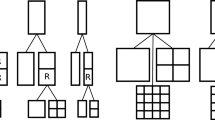Abstract
The existing noise in video/image will not only reduce visual quality, but also will adversely affect the subsequent processing as compression, encoding, transmission and storage. Hence, the denoising technology for video/image is significant in the whole media industry. In this paper, a maximum a posteriori (MAP) decoding for KMV-Cast pseudo-analog video transmission has been proposed to further eliminate the residual noise in the received video/image. First, a noise decomposition model based on multidimensional plane has been proposed. Then, the residual noise in KMV-Cast scheme has been shown to obey Gaussian distribution. Finally, the estimation of the residual noise has been derived for the purpose of maximizing the PSNR of the reconstructed video/image. The simulation results have shown that the proposed decoding method has the best performance compared with other two algorithms, such as KMV-Cast and SoftCast.










Similar content being viewed by others
References
Cisco (2017) Cisco visual networking index: global mobile data traffic forecast update 2016–2021 white paper
Chen S, Zhao J (2014) The requirements, challenges, and technologies for 5G of terrestrial mobile telecommunication. IEEE Commun Mag 52(5):36–43
Maggioni M, Sánchez-Monge E, Foi A (2014) Joint removal of random and fixed-pattern noise through spatiotemporal video filtering. IEEE Trans Image Process 23(10):4282–4296
Malinski L, Smolka B (2016) Fast averaging peer group filter for the impulsive noise removal in color images. J Real-Time Image Proc 11(3):427–444
Wen B, Ravishankar S, Bresler Y (2015) Video denoising by online 3D sparsifying transform learning. In: Proceedings of ICIP, pp 118–122
Lee HY, Hoo WL, Chan CS (2015) Color video denoising using epitome and sparse coding. Expert Syst Appl 42(2):751–759
Llordén GR, Ferrero G, Martin M (2015) Anisotropic diffusion filter with memory based on speckle statistics for ultrasound images. IEEE Trans Image Process 24(1):345–358
Mittal A, Moorthy AK, Bovik AC (2012) No-reference image quality assessment in the spatial domain. IEEE Trans Image Process 21(12):4695–4708
Chen B, Xing L, Liang J, Zheng N, Principe JC (2014) Steady-state mean-square error analysis for adaptive filtering under the maximum correntropy criterion. IEEE Signal Process Lett 21(7):880–884
Kang X, Stamm MC, Peng A, Liu KR (2013) Robust median filtering forensics using an autoregressive model. IEEE Trans Inf Forensics Secur 8(9):1456–1468
Lu CT, Chou TC (2012) Denoising of salt-and-pepper noise corrupted image using modified directional-weighted-median filter. Pattern Recogn Lett 33(10):1287–1295
Zhang P, Li F (2014) A new adaptive weighted mean filter for removing salt-and-pepper noise. IEEE Signal Process Lett 21(10):1280–1283
Yang Q (2015) Stereo matching using tree filtering. IEEE Trans Pattern Anal Mach Intell 37(4):834–846
Horng SJ, Hsu LY, Li T, Qiao S, Gong X, Chou HH, Khan MK (2013) Using sorted switching median filter to remove high-density impulse noises. J Vis Commun Image Represent 24(7):956–967
Nasimudeen A, Nair MS, Tatavarti R (2012) Directional switching median filter using boundary discriminative noise detection by elimination. Signal, Image and Video Processing 6(4):613– 624
Naghizadeh M (2012) Seismic data interpolation and denoising in the frequency-wavenumber domain. Geophysics 77(2):71–80
Parrilli S, Poderico M, Angelino CV, Verdoliva L (2012) A nonlocal SAR image denoising algorithm based on LLMMSE wavelet shrinkage. IEEE Trans Geosci Remote Sens 50(2):606–616
Huang X-L, Wu J, Hu F (2017) Knowledge enhanced mobile video broadcasting (KMV-cast) framework with cloud support. IEEE Trans Circuits Syst Video Technol 27(1):6–18
Huang X-L, Tang X-W, Huan X-N, Wang P, Wun J (2017) Improved KMV-cast with BM3D denoising. Mobile Network and Application 1–8
Jakubczak S, Katabi DA (2011) A cross-layer design for scalable mobile video. In: Proceedings of ACM mobicom, pp 289–300
Acknowledgements
This work is supported by the National Natural Science Foundation of China under Grant No.61631017 and No.U1733114.
Author information
Authors and Affiliations
Corresponding author
Rights and permissions
About this article
Cite this article
Tang, XW., Huan, XN. & Huang, XL. Maximum a Posteriori Decoding for KMV-Cast Pseudo-Analog Video Transmission. Mobile Netw Appl 23, 318–325 (2018). https://doi.org/10.1007/s11036-017-0949-z
Published:
Issue Date:
DOI: https://doi.org/10.1007/s11036-017-0949-z




